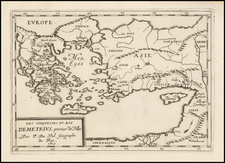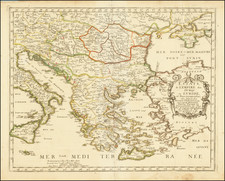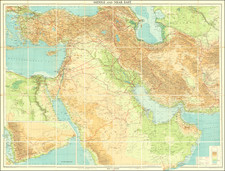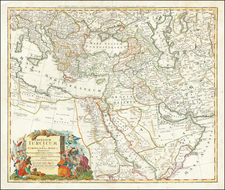Exceedingly Rare View of Istanbul
Very rare bird’s-eye view of Istanbul from the mid-sixteenth century by the enigmatic Balthasar Jenichen, one of the most sought after early engravers of the period.
Based on Münster’s version (1544) of Vavasorre’s view (1520), this map was influential and continued to be the pattern for similar views into the seventeenth century. This Jenichen example, however, is the rarest of any of the related views.
Jenichen's view shows the city from across the Bosphorus, as if the viewer was in the village of Scutari (Üsküdar). The city is shown with an emphasis on its fortifications and famous buildings. Pera-Galata is across the Golden Horn, to the right of the view.
Many of the great buildings of the city are evident, including the Topkapi Palace. The Hagia Sophia is near to the palace, while the many-domed Fatih Mosque complex sprawls toward the western city walls. Just outside the city walls, at left, is the rising Tekfur Palace. In Pera are the new shipyards and the waters around the city are full of vessels.
Jenichen’s view is an improvement on Münster’s. It is more finely engraved. While Münster’s key identifies seven features with the letters A-F (and Pera), the Jenichen includes 45 sites of interest. It also includes a compass rose, indicating that the view is west-oriented.
Sixteenth-century mapping of Istanbul
This view is part of a sequence of that showed the city as it grew in size and importance in the sixteenth century. The first surviving map to show a bird’s-eye-view of the city in this configuration was by Giovanni Andrea Vavassore. Published in Venice in 1520, the view was clearly the inspiration for later productions by Sebastian Münster (1544), Jenichen (ca. 1570), and Braun and Hogenberg (1572). Vavassore, in turn, supposedly based his view on a 1480 map by Giovanni Bellini, but it has not survived.
Both Münster and Braun and Hogenberg improved upon their predecessor’s work, adding details to the grand buildings of the city. For example, the Hippodrome is much more accurately rendered, while many other churches and administrative buildings are more precisely located and depicted. Jenichen seems to have patterned his own view after Münster’s, with the addition of more items in the key.
The main difference between the Münster and the Braun and Hogenberg are the decorative features along the bottom of the view. Sulieman the Magnificent (1494-1566) sits proudly atop a majestic steed, surrounded by armed attendants. To his left and right are roundels showing the sultans of the Ottoman Empire.
Sulieman strengthened the empire and terrified the Christian leaders of Europe. The title of the Braun and Hogbenberg view, Byzantium Nunc Costantinopolis, is likely a European attempt to undermine the legitimacy of the Ottomans, suggesting the earlier presence and power of the Byzantine Empire.
This view of the city continued to be influential, affecting the layout of views well into the following century. For example, Jansson reprinted the Braun and Hogenberg view (which appeared in two states) in a third state in his own town book in the mid-seventeenth century. Versions of the view were printed into the nineteenth century.
Constantinople
The city of Istanbul, previously known as Constantinople, has its roots in the seventh century BCE. By the first century BCE, Byzantium was a thriving settlement. The independence of the city ended in the late second century CE, when Septimus Severus and his Roman army conquered it by siege. Severus rebuilt the damage he caused and the city soon became a prominent Roman metropolis thanks in large part to the its natural defensibility and strategic location.
These attributes led Constantine the Great to make the city the capital of the Roman Empire; it was renamed Constantinople in 330 CE. A Christian city, Constantinople was soon defined by its churches, including the Hagia Sophia and the Hagia Irene.
The city survived the fall of Rome and continued to fashion themselves as the heir to the Roman Empire for over a thousand years. The Ottomans conquered Constantinople in 1453, making it the capital of their own empire. The Turkish government changed the city’s name to Istanbul in 1930.
Interestingly, the term Byzantine was not applied to an empire until the nineteenth century. First coined by a Hapsburg scholar, Hieronymous Wolf, in 1557, it was taken up by historians to refer to the later or eastern Roman Empire.
Rarity
The view is of the utmost rarity.
We locate only one other example for sale, which was offered without the key at the bottom (likely a proof state).
Very little is known of Balthasar Jenichen. He was a German goldsmith, engraver, and publisher who worked in Nuremberg between ca. 1560 and 1599, when he likely died. He started work in Virgil Solis' shop. When Solis died in 1562, Jenichen married his widow and continued the business. A document dating to 1621 mentions that Jenichen's widow sold a number of copper tablets (plates) to Senator Paul Behaim.









![[Istanbul] Die Statt Constantinopel in Turckey](https://storage.googleapis.com/raremaps/img/small/63022.jpg)



![[Empire of Alexander The Great] Antiquor? Imperiorum Tabula in qua prae caeteris, Macendonia seu Alexandri Magni et Expeditiones exarantur . . .](https://storage.googleapis.com/raremaps/img/small/70608.jpg)
